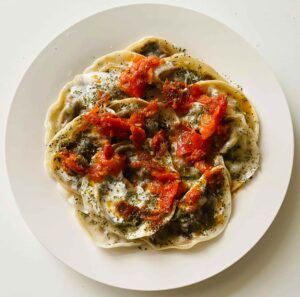At MAMA BELLA, we honor the roots of Sardinian cooking—food that’s generous, honest, and meant to be shared with family. If you’re looking to elevate your Italian sauces at home, understanding San Marzano tomatoes is essential. These plum tomatoes, traditionally grown in the Agro Sarnese–Nocerino area near Mount Vesuvius in Italy’s Campania region, are celebrated for their natural sweetness, gentle acidity, and meaty texture. In this guide, we’ll explore what makes San Marzano tomatoes the gold standard for sauce-making, how they differ from common varieties like Roma, and how we plan to use them within Mama Bella’s Sardinian approach to hearty, soulful cuisine in Dubai.
Key Takeaways:
- San Marzano tomatoes develop a sweet, concentrated flavor and tender flesh thanks to Campania’s volcanic soils and mild Mediterranean climate—ideal for balanced, velvety sauces.
- They contain fewer seeds and less water than many other tomatoes, producing a thicker, silkier sauce with less cooking time and minimal bitterness.
- At Mama Bella in Dubai (pre-launch), San Marzano tomatoes will anchor menu concepts such as slow-simmered sughi for handcrafted pastas and simple, bright sauces for wood-fired pizzas.
What Makes San Marzano Tomatoes Unique?
San Marzano tomatoes stand apart because of terroir and tradition. The growing zone around Mount Vesuvius provides mineral-rich volcanic soils that encourage natural sweetness without heavy acidity. Long, warm days and cool nights allow the fruit to ripen slowly, concentrating sugars and aromas while maintaining a fresh, lifted finish. The result is a tomato that tastes clean and sweet, with a gentle tang—perfect for sauces that don’t need added sugar to feel balanced.
Another hallmark is the tomato’s anatomy. San Marzano fruits are elongated with dense flesh and fewer seeds, so the pulp cooks down into a plush, cohesive sauce. Traditional trellising keeps fruit off the ground and promotes even sun exposure, while hand-harvesting preserves the tomatoes’ integrity and minimizes bruising. When you begin with a tomato that naturally tastes this good, you can cook with restraint and let the ingredients speak for themselves.
San Marzano vs. Other Varieties
It’s helpful to compare San Marzano with widely available Roma tomatoes. Romas are reliable and versatile, offering firm texture and a clean, tomato-forward flavor that’s great for salsas, roasting, and quick sauces. San Marzano tomatoes, however, tip the scales toward sweetness and depth, with a lower perceived acidity and a notably silky mouthfeel once simmered. This profile makes them a favorite for classic Italian sauces where balance and texture matter most—think marinara, pomodoro, or a simple pizza sauce that doesn’t overshadow milky mozzarella or fragrant basil.
In practical terms: choose Roma when you want structure in salads or quick, bright sauces. Choose San Marzano when you want plushness and sweetness to carry slow-simmered dishes—especially when the sauce is the star.
Why They’re the Gold Standard for Italian Sauces
The “gold standard” label isn’t about prestige; it’s about performance. A great sauce should be balanced, velvety, and flavorful without tasting harsh or metallic. San Marzano tomatoes provide that foundation naturally, allowing restraint in the pan: less sugar, fewer additives, and shorter reduction times. With quality olive oil, a whisper of garlic, and fresh basil, a proper San Marzano sauce tastes complete—layered yet clean, rich yet light on its feet.
Classic Culinary Uses
Marinara: Sweat finely chopped onion and sliced garlic in olive oil over low heat. Add crushed San Marzano tomatoes, a pinch of salt, and torn basil. Simmer gently for 25–35 minutes until the sauce glistens and the edges taste sweet—no bitterness, no excessive tang.
Pizza Sauce: Blend or crush the tomatoes by hand, add a little salt and a drizzle of extra virgin olive oil. Spread sparingly over stretched dough so the crust can breathe. Top with fior di latte or buffalo mozzarella and a few basil leaves, then bake in a hot oven for a balanced, bright pie.
Pomodoro: A minimalist pasta sauce benefits most from San Marzano’s natural sweetness. Sauté garlic, add the tomatoes, and finish with basil and a knob of butter for gloss. The result is a plush coating sauce that bonds beautifully to al dente spaghetti.
How Mama Bella Brings San Marzano Tomatoes to Dubai
Mama Bella is a premium Sardinian-inspired Italian restaurant concept located within Kempinski, The Boulevard in Dubai (pre-launch). Our culinary vision centers on family-style sharing, handcrafted pasta made daily, and wood-fired cooking techniques that highlight Mediterranean ingredients. Within that vision, San Marzano tomatoes are a cornerstone of our sauce program. The goal is not to mask, but to reveal—letting the tomato’s character carry the dish.
Expect menu concepts that showcase restraint and clarity: a bright sugo al pomodoro for tagliatelle, a slow-simmered marinara for seafood, and a delicate pizza sauce that respects blistered crust and creamy cheese. If you’d like to know more about our philosophy and the Sardinian heritage behind it, explore our story on the About Us page. Curious about what we’re crafting? You can preview evolving ideas on our menu as we move toward opening.
The Sardinian Lens: Simplicity, Quality, Family
Sardinian cuisine prizes simple combinations that feel generous at the table. San Marzano tomatoes fit naturally into that mindset. A bowl of fresh, handcrafted pasta—tossed in sugo, finished with basil and olive oil—embodies the island’s respect for ingredients. Shared pizzas from a wood-fired oven show the same restraint: a thin veil of sauce, a few well-chosen toppings, and heat that kisses the dough. This is the kind of food that welcomes conversation and invites a longer meal—exactly the experience we celebrate at Mama Bella.
Planning a gathering? Our approach is designed around communal dining. Order a spread of antipasti, a couple of pastas to share, and a pizza or two, and let the table fill naturally. For inspiration on experiences and occasions, browse ideas for dinner in Dubai and discover how a tomato-led menu can anchor a cozy, celebratory evening.
How to Identify Authentic San Marzano Tomatoes
When purchasing, look for the Denominazione di Origine Protetta designation—often printed as “San Marzano dell’Agro Sarnese–Nocerino DOP.” This mark indicates tomatoes grown within the protected area under specific standards. Authentic cans typically list whole peeled tomatoes, basil leaf (optional), and tomato juice—without unnecessary sugars or heavy additives. The fruit should be elongated, not round; the flavor should lean sweet and rich, with a clean, gentle finish.
A quick kitchen check: crush a tomato with your fingers. You should feel dense flesh and see few seeds and little watery liquid. Taste should be bright and sweet rather than sharp or metallic. If your sauce tastes balanced before you add much else, you’re likely working with the right tomatoes.
Nutritional Notes
Great flavor and good nutrition can go hand in hand. San Marzano tomatoes are naturally rich in vitamin C and potassium and contain antioxidants such as lycopene. Because the fruit is naturally sweet and balanced, you can keep sauces minimal—less sugar, fewer additions—without sacrificing taste. Pairing tomato-based sauces with whole-grain pasta and olive oil adds fiber and heart-healthy fats, rounding out a meal that’s both satisfying and nourishing.
Frequently Asked Questions
What makes San Marzano tomatoes the gold standard for Italian sauces?
They deliver natural sweetness, low perceived acidity, and dense flesh that cooks into a velvety sauce. This balance lets you create honest, ingredient-driven sauces without masking flavors—precisely the approach we champion at Mama Bella.
How should I use San Marzano tomatoes in my cooking?
Use them whole and crush by hand for a rustic marinara, purée for a smooth pomodoro, or blend lightly for pizza sauce. Keep heat moderate and seasoning restrained so the tomato’s character remains front and center.
Are San Marzano tomatoes worth the price?
If sauce quality is your priority, yes. Their texture and flavor reduce the need for extra sugar and long reductions. In most kitchens, that translates into better results with fewer steps.
Can I substitute other tomatoes for San Marzano in recipes?
You can. Romas and other plum varieties work, but you may need longer simmering or a touch of butter or olive oil to soften edges. With San Marzano, that balance tends to happen naturally.
What’s the best way to store them?
Keep unopened cans in a cool, dark pantry. Once opened, transfer to a non-reactive, airtight container and refrigerate for up to a few days. For longer storage, freeze leftover sauce in portions.
Where can I learn more about Mama Bella and San Marzano–based dishes?
Explore our Sardinian roots and culinary philosophy on the Sardinian restaurant in Dubai page, discover pasta shapes and sauce pairings on the best pasta in Dubai page, or preview what we’re crafting on the menu. When you’re ready to register interest for future bookings, visit our reservation page.
San Marzano tomatoes may be grown far from Dubai, but their spirit—purity, sweetness, and balance—aligns perfectly with the Sardinian values we celebrate at Mama Bella. As we prepare to open within Kempinski, The Boulevard, our promise is simple: respect the ingredient, honor the tradition, and create meals designed to bring people together.






